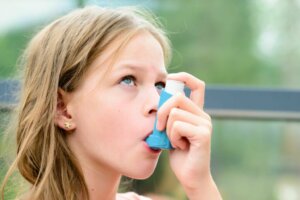Risk Factors and Causes of Asthma

According to estimates by the World Health Organization, there are currently about 235 million people with asthma. Although the medical literature has written much about it, there’s no consensus on the true causes of asthma.
Still, theories suggest that it’s a convergence of factors, the most important being of a genetic and environmental nature.
Asthma is a very common condition during childhood, but with a significant prevalence in adults. Knowing what encourages its development and its possible risk factors is useful in order to determine a plan that helps to control it. After all, the WHO considers it to be a public health problem.
Main causes of asthma
Although the causes of asthma haven’t yet been defined, much progress has been made in understanding it. For example, we know that it’s more frequent in westernized countries, perhaps because of the environmental repercussions related to urban life.
Research has attempted to reveal its etiology, although practice indicates that a single factor may not be enough to trigger it. The causes of asthma remain a mystery, although the disease can be influenced in principle by the following.
Genetic predisposition

The relationship between genetics and asthma is well documented. Although the presence of the disease in the family doesn’t ensure its development, it does considerably increase the chances of suffering it if we compare it to people with no previous history.
The American Lung Association estimates that genetic predisposition increases the chances of contracting the disease between 3 and 6 times. These percentages increase if both biological parents have the condition, as has been demonstrated at least by etiological investigations of the genes.
There’s a certain consensus that an external agent is necessary to activate this genetic predisposition, and so the causes of asthma are considered to be multifactorial. Still, those with a family history should be aware of their natural predisposition to get it.
Environmental factors
According to some indications, environmental factors are the main trigger for asthma. A good part of the diagnoses can be explained by this, accompanied by assumptions of other triggering agents. Many of them are related to the disease, among which we can highlight:
- Allergens: People who are sensitive to allergens, or have a genetic predisposition to them, are more likely to develop asthma at some point in their life. Today it’s considered one of the most frequent causes of asthma and involves a variety of manifestations (from eczema to allergic rhinitis).
- Irritants: Exposure to irritants can trigger asthma, whether or not there’s an allergic sensitivity. For example, dust, fumes, and some chemicals can cause respiratory irritation.
- Smoke – in all its variants, including smoke produced by tobacco, firewood, industries and vehicles. A relationship has been found between asthma and environmental pollution, and so that could be an important cause of its later development (especially with prolonged exposure during the first months of life).
- Climate: Studies and other publications have reported the relationship between climate and asthma. This would explain, at least partially, the increase in attacks in patients when there’s a decrease in temperature. This would also include its apparent prevalence in less warm areas.
Other environmental agents such as mold, pollen, animal hair, urine and wastes from some insects can also cause asthma.
Respiratory infections
A relationship between acute respiratory infections and the development of asthma has been found. Studies indicate that the chances of contracting the disease increase when you have lower respiratory infections during the first months of life.
The role of respiratory infections in the morbidity of patients who already have the condition has been studied. In principle, those that come from rhinovirus causes are more prone to asthma exacerbations, a catalyst to be taken into account in risk groups.
These are the most frequent causes of asthma, although we can also include other factors such as:
- High consumption of medications: Especially non-steroidal anti-inflammatory drugs and beta-blockers.
- Some food groups – which vary according to each person, although they’re usually related to allergies. This cause is more frequent in children and young people.
- Psychological disorders – related in principle to emotional changes, such as anxiety, stress, or depression.
Risk factors for asthma

Some asthma risk factors have been identified that, together with their original triggers (genetic predisposition or environmental alterations), can create the perfect cocktail for the development of the disease. Among the main ones, we can highlight:
- Smoking: Several studies and other publications suggest that smoking increases the chances of developing asthma. The decline in lung function is counterproductive regardless of age, not to mention that it’s the trigger for other more serious diseases such as lung cancer.
- Living or working in polluted areas: Environmental pollution hasn’t stopped growing in recent decades. Living permanently in areas with some type of contamination is counterproductive for the respiratory tract.
- Obesity: Obesity is linked to the development of many diseases, such as type 2 diabetes, heart conditions, and hypertension. We also know its relationship to asthma, especially in its more serious variants.
- Living with microbes or maintaining poor hygiene: this is because it increases the chances of contracting a viral or bacterial infection. For example, interaction with mites can easily trigger asthma in the company of other catalysts.
- Stress: As mentioned in the possible causes, alterations in mood aren’t positive for the control or development of the disease. A person who lives repeatedly exposed to stress is more likely to suffer from asthma.
We can highlight other risk factors such as diet, the practice of moderate or intense exercises, and being in close contact with pets.
Can asthma be prevented?
Keep in mind that asthma is more likely to develop from multi-causal factors than from just one trigger. In view of this, the evidence indicates that people can implement a series of habits to help prevent their appearance or, at least, to reduce the severity of the symptoms if they do appear.
While it’s true that asthma can’t be prevented, a few small things go a long way for those with a family history. For example, managing stress, keeping rooms dust-free, keeping warm when the temperature drops, losing weight, or quitting smoking will benefit you in the short and long term.
According to estimates by the World Health Organization, there are currently about 235 million people with asthma. Although the medical literature has written much about it, there’s no consensus on the true causes of asthma.
Still, theories suggest that it’s a convergence of factors, the most important being of a genetic and environmental nature.
Asthma is a very common condition during childhood, but with a significant prevalence in adults. Knowing what encourages its development and its possible risk factors is useful in order to determine a plan that helps to control it. After all, the WHO considers it to be a public health problem.
Main causes of asthma
Although the causes of asthma haven’t yet been defined, much progress has been made in understanding it. For example, we know that it’s more frequent in westernized countries, perhaps because of the environmental repercussions related to urban life.
Research has attempted to reveal its etiology, although practice indicates that a single factor may not be enough to trigger it. The causes of asthma remain a mystery, although the disease can be influenced in principle by the following.
Genetic predisposition

The relationship between genetics and asthma is well documented. Although the presence of the disease in the family doesn’t ensure its development, it does considerably increase the chances of suffering it if we compare it to people with no previous history.
The American Lung Association estimates that genetic predisposition increases the chances of contracting the disease between 3 and 6 times. These percentages increase if both biological parents have the condition, as has been demonstrated at least by etiological investigations of the genes.
There’s a certain consensus that an external agent is necessary to activate this genetic predisposition, and so the causes of asthma are considered to be multifactorial. Still, those with a family history should be aware of their natural predisposition to get it.
Environmental factors
According to some indications, environmental factors are the main trigger for asthma. A good part of the diagnoses can be explained by this, accompanied by assumptions of other triggering agents. Many of them are related to the disease, among which we can highlight:
- Allergens: People who are sensitive to allergens, or have a genetic predisposition to them, are more likely to develop asthma at some point in their life. Today it’s considered one of the most frequent causes of asthma and involves a variety of manifestations (from eczema to allergic rhinitis).
- Irritants: Exposure to irritants can trigger asthma, whether or not there’s an allergic sensitivity. For example, dust, fumes, and some chemicals can cause respiratory irritation.
- Smoke – in all its variants, including smoke produced by tobacco, firewood, industries and vehicles. A relationship has been found between asthma and environmental pollution, and so that could be an important cause of its later development (especially with prolonged exposure during the first months of life).
- Climate: Studies and other publications have reported the relationship between climate and asthma. This would explain, at least partially, the increase in attacks in patients when there’s a decrease in temperature. This would also include its apparent prevalence in less warm areas.
Other environmental agents such as mold, pollen, animal hair, urine and wastes from some insects can also cause asthma.
Respiratory infections
A relationship between acute respiratory infections and the development of asthma has been found. Studies indicate that the chances of contracting the disease increase when you have lower respiratory infections during the first months of life.
The role of respiratory infections in the morbidity of patients who already have the condition has been studied. In principle, those that come from rhinovirus causes are more prone to asthma exacerbations, a catalyst to be taken into account in risk groups.
These are the most frequent causes of asthma, although we can also include other factors such as:
- High consumption of medications: Especially non-steroidal anti-inflammatory drugs and beta-blockers.
- Some food groups – which vary according to each person, although they’re usually related to allergies. This cause is more frequent in children and young people.
- Psychological disorders – related in principle to emotional changes, such as anxiety, stress, or depression.
Risk factors for asthma

Some asthma risk factors have been identified that, together with their original triggers (genetic predisposition or environmental alterations), can create the perfect cocktail for the development of the disease. Among the main ones, we can highlight:
- Smoking: Several studies and other publications suggest that smoking increases the chances of developing asthma. The decline in lung function is counterproductive regardless of age, not to mention that it’s the trigger for other more serious diseases such as lung cancer.
- Living or working in polluted areas: Environmental pollution hasn’t stopped growing in recent decades. Living permanently in areas with some type of contamination is counterproductive for the respiratory tract.
- Obesity: Obesity is linked to the development of many diseases, such as type 2 diabetes, heart conditions, and hypertension. We also know its relationship to asthma, especially in its more serious variants.
- Living with microbes or maintaining poor hygiene: this is because it increases the chances of contracting a viral or bacterial infection. For example, interaction with mites can easily trigger asthma in the company of other catalysts.
- Stress: As mentioned in the possible causes, alterations in mood aren’t positive for the control or development of the disease. A person who lives repeatedly exposed to stress is more likely to suffer from asthma.
We can highlight other risk factors such as diet, the practice of moderate or intense exercises, and being in close contact with pets.
Can asthma be prevented?
Keep in mind that asthma is more likely to develop from multi-causal factors than from just one trigger. In view of this, the evidence indicates that people can implement a series of habits to help prevent their appearance or, at least, to reduce the severity of the symptoms if they do appear.
While it’s true that asthma can’t be prevented, a few small things go a long way for those with a family history. For example, managing stress, keeping rooms dust-free, keeping warm when the temperature drops, losing weight, or quitting smoking will benefit you in the short and long term.
- Akerman, M. J., Calacanis, C. M., & Madsen, M. K. Relationship between asthma severity and obesity. Journal of Asthma. 2004; 41(5): 521-526.
- Antó, J. M.The causes of asthma: the need to look at the data with different eyes. Allergy. 2004; 59(2); 121-123.
- Barnes, K. C. Genetic studies of the etiology of asthma. Proceedings of the American Thoracic Society. 2001; 8(2): 143-148.
- Beasley, R., Crane, J., Lai, C. K., & Pearce, N. Prevalence and etiology of asthma. Journal of allergy and clinical immunology. 2000; 105(2): S466-S472.
- Beasley, R., Semprini, A., & Mitchell, E. A. Risk factors for asthma: is prevention possible?. The Lancet. 2015; 386(9998): 1075-1085.
- Boulet, L. P. Asthma and obesity. Clinical & Experimental Allergy. 2013; 43(1): 8-21.
- Busse, W. W., Lemanske Jr, R. F., & Gern, J. E. Role of viral respiratory infections in asthma and asthma exacerbations. The Lancet, 376(9743). 2010; 826-834.
- Brito, F. F., & Gimeno, P. M. Asma y contaminación. ESPACIO ASMA. 2011; 4(1): 8.
- Hashimoto, M., Fukuda, T., Shimizu, T., Watanabe, S., Watanuki, S., Eto, Y., & Urashima, M. Influence of climate factors on emergency visits for childhood asthma attack. Pediatrics international. 2004; 46(1): 48-52.
- McLeish, A. C., & Zvolensky, M. J. Asthma and cigarette smoking: a review of the empirical literature. Journal of Asthma. 2010; 47(4): 345-361.
- McKeever, T. M., & Britton, J. Diet and asthma. American journal of respiratory and critical care medicine. 2004; 170(7): 725-729.
- OYARZÚN, M. Factores ambientales relacionados con la gravedad del asma. Revista chilena de enfermedades respiratorias. 2004: 20(1): 25-29.
- Puig, C., Fríguls, B., Gómez, M., García-Algar, Ó., Sunyer, J., & Vall, O. Relación entre las infecciones respiratorias de vías bajas durante el primer año de vida y el desarrollo de asma y sibilancias en niños. Archivos de Bronconeumología. 2010; 46(10): 514-521.
- Plaza, V., Quirce, S., Delgado, J., Martínez Moragón, E., & Pérez de Llano, L. Debate multidisciplinar de expertos. Asma no controlada: causas, consecuencias y posibles soluciones. In Anales del Sistema Sanitario de Navarra. 20016; Vol. 39, No. 3, pp. 357-370. Gobierno de Navarra. Departamento de Salud.
- Rojas-Martinez, A., Santillan, A. A., Delgado-Enciso, I., & Barrera-Saldana, H. A. Genetic aspects of asthma. Revista de investigacion clinica; organo del Hospital de Enfermedades de la Nutricion. 2000; 52(4): 441-450.
- Soler Fonseca, V., Pérez Díaz, X., Rigñack Ramirez, L., & Hevia González, L. E. Relación entre las infecciones respiratorias agudas altas y el asma bronquial. Revista Cubana de Medicina General Integral. 2013; 29(3): 297-305.
- Toskala, E., & Kennedy, D. W. Asthma risk factors. In International forum of allergy & rhinology. 2015; Vol. 5, No. S1, pp. S11-S16.
- Thomson, N. C., Chaudhuri, R., & Livingston, E. Asthma and cigarette smoking. European respiratory journal. 2004; 24(5): 822-833.
- Subbarao, P., Mandhane, P. J., & Sears, M. R. Asthma: epidemiology, etiology and risk factors. Cmaj. 2009; 181(9): E181-E190.
- Verlato, G., Calabrese, R., & Marco, R. D. Correlation between asthma and climate in the European Community Respiratory Health Survey. Archives of Environmental Health: An International Journal. 2002; 57(1): 48-52.
- Weiland, S. K., Hüsing, A., Strachan, D. P., Rzehak, P., & Pearce, N. Climate and the prevalence of symptoms of asthma, allergic rhinitis, and atopic eczema in children. Occupational and environmental medicine. 2004; 61(7): 609-615.
Este texto se ofrece únicamente con propósitos informativos y no reemplaza la consulta con un profesional. Ante dudas, consulta a tu especialista.







